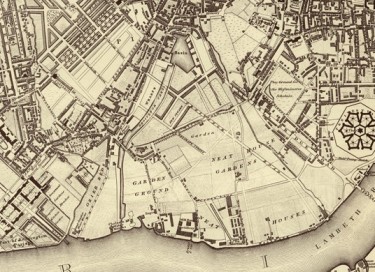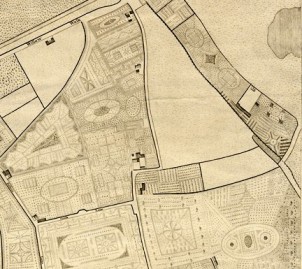Today, Pimlico is a bustling , diverse and densely-populated part of London. It occupies the north bank of the Thames between Vauxhall Bridge and Chelsea Bridge and is perhaps best known for its handsome white stucco buildings, part of Thomas Cubitt’s distinctive development of the area in early 19th century.
Cubitt’s building plan for Pimlico was implemented in 1820s, and radically changed the nature of this area of London. Before his famous residential terraces were built, much of the land had been dedicated to the growing industry and Pimlico was famous as the home of the Neat House Gardens.
In the 17th and 18th centuries, market gardens surrounded London and provided the fruit and vegetables on which the city’s inhabitants thrived. The Neat House Gardens were named after the Manor of Neyte and occupied approximately 100 acres, with cauliflowers, asparagus, artichokes, spinach, radishes and melons featuring among its produce. The land was ideal for gardening as it was low-lying with a high water table. Pasture was not far away, so there was also easy access to large quantities of manure.
Alehouses cropped up all around the gardens, and Neat Houses became known as a place of recreation and revelry. Many people travelled from the city to the many tea gardens in the area, and among them was one Samuel Pepys:
After the play, we into the house, and spoke with Knipp, who went abroad with us by coach to the Neat Houses in the way to Chelsy; and there, in a box in a tree, we sat and sang, and talked and eat; my wife out of humour, as she always is, when this woman is by.
Diary of Samuel Pepys, 1August 1667

The Monster Tavern was one of the many tea gardens and ale houses nearby Neat House Gardens. This watercolour shows the tavern circa 1820.
Henry Wise, Royal Gardener to Queen Anne and designer of Kensington Gardens had gardens at Neat Houses, but many of the gardeners were tenants who farmed just a small patch of land.

This section from an estate map of 1725 shows Mr Wise’s Estate next to the Bailiwick of Neat. Much of the land was divided into small tenancies.
At the turn of the 19th Century the population of London was expanding rapidly and there was increasing pressure on the gardeners to give up their land to prospective builders. John Johnson bought the lease for much of the land in Pimlico in 1817 but found his proposals constantly thwarted by the gardeners. In 1825 Johnson gave up his battle against the gardeners, but threat to Neat Houses remained as real as ever as he sold his interest in the land to Thomas Cubitt.

By 1827 the urban sprawl surrounded Neat House Gardens. It wouldn’t be long until these too would fall victim to the city’s expansion.
The writing was on the wall for the Gardens and it was now only a matter of time before roads and large-scale building works would change the character of Pimlico entirely. Today nothing remains of The Neat House Gardens, but if you come along to Westminster Archives Centre you can relive their glory days through our collections of books, maps and prints.
[Jo]
Filed under: History of food Tagged: 18th century history, farming, food supply, gardens, history of food, maps, market gardens, Neat House Gardens, Pimlico, Thomas Cubitt





















